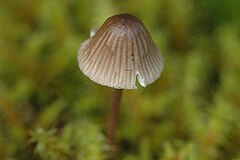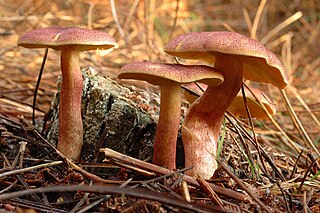
Tricholomopsis is a genus of fungi closely related to the large genus Tricholoma. Its best known member and type species is Tricholomopsis rutilans. The name means appearing like Tricholoma. The genus has a widespread distribution, and contains about 30 species. Tricholomopsis was described in 1939 by American mycologist Rolf Singer.

Baeospora is a genus of mushroom-producing fungi. It is variously classified in the families Tricholomataceae or Marasmiaceae, though as of 2007, these groups are undergoing revision. It has been found to fall into the "hydropoid clade", though no formal Linnaean taxon has been designated based on this classification. The genus was circumscribed by mycologist Rolf Singer in 1938. The most recently described species, B. occidentalis, is a snowbank fungus that was discovered in montane coniferous forests of the western USA.

Leucopholiota is a genus of fungi in the Tricholomataceae family of mushrooms. It consists of the species Leucopholiota decorosa and Leucopholiota lignicola.

Pseudohiatula is a genus of fungi in the family Physalacriaceae. It was originally described as a subgenus of Mycena by the mycologist Rolf Singer before he moved to its own genus two years later. It was formerly thought to belong in the family Tricholomataceae, but a molecular phylogenetics study found it to be more closely The genus Cyptotrama in the Physalacriaceae. Rolf Singer had previously hypothesized these two genera to be closely related based on morpological features in 1986. It contains five species that are widely distributed in tropical areas.
Callistodermatium is a fungal genus in the family Tricholomataceae. It is a monotypic genus, and contains the single species Callistodermatium violascens. The holotype was found in Brazil, and described by mycologist Rolf Singer in 1981.
Mycoalvimia is a genus of fungus in the Tricholomataceae family. It is a monotypic genus, and contains the single species Mycoalvimia theobromicola, found in Brazil.
Pegleromyces is a genus of fungi in the Tricholomataceae family. It is a monotypic genus, containing the single species Pegleromyces collybioides, found in Brazil and described as new to science by mycologist Rolf Singer in 1981.
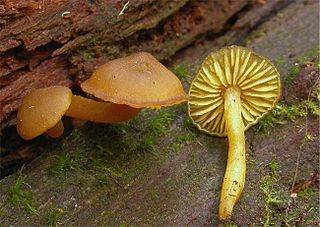
Callistosporium is a genus of fungi in the family Tricholomataceae. The genus is widespread, and contains 13 species.
Dennisiomyces is a genus of fungi in the family Tricholomataceae. Described by mycologist Rolf Singer in 1955, the genus contains five species found in South America.

Leucoinocybe is a fungal genus in the family Tricholomataceae. This is a monotypic genus, containing the single species Leucoinocybe lenta, found in Europe.

Phyllotopsis is a genus of fungi in the Tricholomataceae family. The widespread genus contain five species that are predominantly in temperate regions.
Physocystidium is a genus of fungi in the Tricholomataceae family. This is a monotypic genus, containing the single species Physocystidium cinnamomeum. This species is found in Trinidad, and was originally described as new to science in 1951 as Collybia cinnamomea by mycologist R.W.G. Dennis; Rolf Singer transferred it to the then newly created genus Physocystidium in 1962.
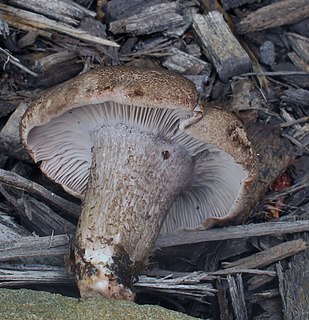
Porpoloma is a genus of fungi in the family Tricholomataceae. The genus contains about 12 species found predominantly in South America. Porpoloma was described by mycologist Rolf Singer in 1952 with P. sejunctum as the type species.
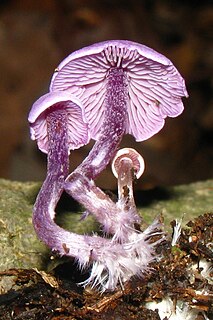
Pseudobaeospora is a genus of fungi in the family Tricholomataceae. A 2008 estimate placed about 20 species in the widespread genus.
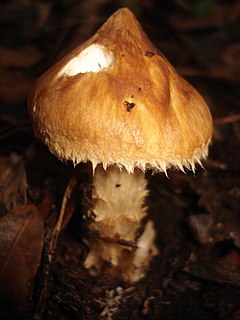
Squamanita is a parasitic genus of agaric fungi formerly classified in the family Tricholomataceae and is now in the Cystodermateae in the Squamanitaceae. The fruitbodies of this genus resemble a normal agaric but they emerge from parasitized fruitbodies of other agarics that Squamanita has deformed. The deformation may be massive and the host may then resemble a lump, or the deformation may be so subtle that the Squamanita appears to be grafted onto the stipe of the host that nearly always fails to form a pileus. Because of the seamless graft-like attachment or the severe deformation of the host into a nonrecognizable blob, early descriptions included features of the host in descriptions of Squamanita as if they were parts of the parasite. This error led to the creation of a separate subgenus because of misinterpretation of host veil tissue as part of the parasite and ultimately a separate genus, Dissoderma. Serendipitous discovery of one parasitized host fruitbody (Galerina) that formed its own pileus that then bore three Squamanita contortipes fruitbodies revealed the parasitic nature of the relationship for that species and the entire genus. This discovery was so shocking that it was featured in Nature magazine under the title 'Mycological mystery tour'. Once the parasitic nature was revealed, the term 'protocarpic tuber' used by earlier authors for the parasitized host base was replaced by the term 'cecidiocarp' or 'cecidiocarpo' in Spanish.

Hemimycena is a genus of fungi in the family Mycenaceae. The genus has a widespread distribution, and according to a 2008 estimate, contains about 50 species. The genus was described by mycologist Rolf Singer in 1938. They lack of amyloid reaction in the spores.

Nothoclavulina is a genus of fungus in the Tricholomataceae family. The genus is monotypic, containing the single species Nothoclavulina ditopa, described by American mycologist Rolf Singer in 1970. The species, found in Argentina, is an anamorphic version of the genus Arthrosporella. The generic name Nothoclavulina is Latin for "false Clavulina".
Callistosporium palmarum is a species of fungus in the Tricholomataceae family, and the type species of the genus Callistosporium. Originally named Gymnopus palmarum by William Alphonso Murrill in 1939, the species was transferred to the genus Callistosporium by Rolf Singer in 1944.
